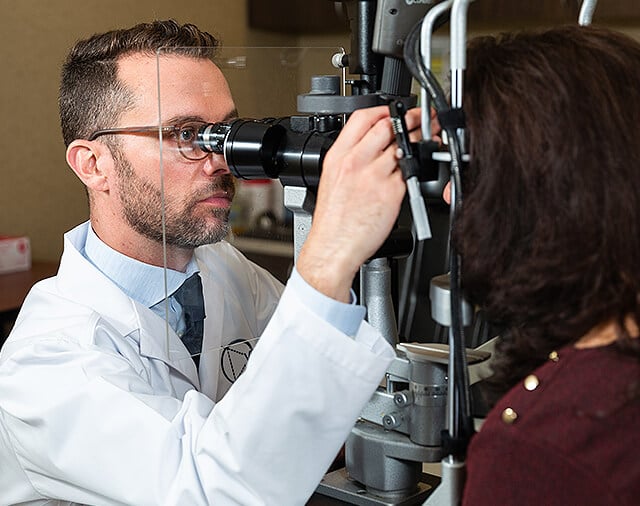Retinal Tears & Retinal Detachments

Choose Vitreoretinal Consultants of NY for Retinal Tears & Retinal Detachment in New York
At Vitreoretinal Consultants of NY, we are dedicated to providing exceptional retinal care to patients across the Greater NYC Metropolitan Area, including Queens, as well as Nassau, Suffolk, Rockland, and Westchester counties. For us, nothing is as important as your eyesight. Contact us with any questions, or schedule an appointment with VRC today.
Types of Retinal Detachment
Retinal detachment is classified into three different subtypes:
- Rhegmatogenous: The most common form, rhegmatogenous retinal detachment is caused by a condition known as posterior vitreous detachment (PVD) in which the vitreous fluid of the eye diminishes and recedes from the retina. As it recedes, the vitreous sometimes pulls on the retina, creating a tear in the tissue. If the vitreous leaks through the tear and gets behind the retina, it can push the retina away from the back of the eye until it detaches completely.
- Exudative: This type of retinal detachment occurs when fluid becomes trapped behind the retina without any tears being present. The fluid builds up and forces the retina to separate from the back of the eye. It is often caused by leaking blood vessels or swelling in the back of the eye.
- Tractional: This form of retinal detachment is most often a complication of diabetes. When blood sugar is too high, it can damage the ocular blood vessels and lead to scarring on the retina. If the scarring increases in size, it can pull on the retina until it separates from the back of the eye.
Flashes, Floaters & Other Symptoms
Retinal tears and detachments are generally painless but can cause noticeable changes to your vision. The most common symptoms associated with retinal tears and detachment is the presence of flashes and/or floaters in your field of vision.
Flashes typically look like little strands of light flickering across your visual field. For some patients, flashes may appear as a streak of light, a bright spot, a jagged line of lightning, a firework-like burst of light, or a camera flash.
Floaters typically look like small floating shapes across your visual field. Some patients describe these shapes as being similar to spots, squiggly lines, small shadows, and thread-like strands. In terms of color and opacity, they can be translucent or dark.
You may also experience a layer of darkness over your vision or blurriness. These symptoms may appear very suddenly or intensify right before a retinal detachment occurs.
How Retinal Tears & Detachments Are Diagnosed
There are a few diagnostic methods that are used to determine whether the retina is torn or detached. These tests include:
- Eye dilation: This is a common eye exam in which special drops are used to keep the pupil open, allowing your physician to get a closer look at the inside of your eye and retinal area.
- Retinal examination: As part of the exam, retina specialists may use a specialized light instrument to get a more detailed view of the eye and identify the presence of any retinal tears, holes, or detachments.
- Ultrasound imaging: This is a non-invasive diagnostic technique that uses high-frequency soundwaves to produce an image. This method helps retina specialists to detect retinal tears and detachments when there is the presence of blood, poor dilation, or some other factor that makes visual detection difficult.
Treatment for Retinal Tears & Detachments
Treatment depends on the severity of the tear or whether the retina has become fully detached. Common treatment options include:
- Laser surgery, also known as photocoagulation: In this procedure, a high-energy laser is used to “spot-weld” the edges of a retinal tear to the underlying tissue, which helps to prevent a total retinal detachment.
- Cryopexy (freezing): This is a procedure in which a freezing probe is applied to the surface of the eye above the tear. The freezing probe causes the area to form scar tissue around the tear, which helps to stabilize the retina, secure it to the wall of the eye, and prevent it from detaching.
- Pneumatic retinopexy: This is a surgical procedure that involves injecting a gas bubble into the center of the eye. The bubble helps to stabilize a detached retina’s position and push it back into its proper place. The retina’s tear is then sealed via cryopexy or photocoagulation.
- Scleral buckling: In this procedure, a retina surgeon secures a piece of silicone or sponge to the white of the eye, which is known as the sclera. This is done close to the spot of the tear so that the sclera will push the detached retina back into place.
- Vitrectomy: This surgical procedure involves the removal of the vitreous humor gel, which is the fluid that fills the eye and provides structure. The gel is removed so that the retina surgeon can get better access to the retina and repair tears or detachments. Once complete, silicone oil, a gas bubble, or saline may be injected into the eye so that the retina remains secure in its proper position.
Although procedures for treating retinal tears and detachments may sound a little intimidating, it’s important to note that the eyes are always anesthetized or numbed before the procedure. Most patients report feeling very little discomfort or pain if any at all.
Retinal Tears & Detachments: FAQ
For more information, please visit the American Society of Retina Specialists's retinal tears and retinal detachment pages.


